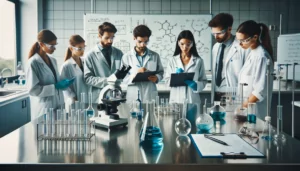In the realm of chemistry, understanding the concept of reactants is fundamental. Reactants play a vital role in chemical reactions, driving the transformation from starting materials to products. In this article, we will delve into the definition of reactants, explore relevant examples, and highlight the key differences between reactants and reagents. Let’s embark on this chemical journey together!

✅ AI Essay Writer ✅ AI Detector ✅ Plagchecker ✅ Paraphraser
✅ Summarizer ✅ Citation Generator
Understanding Reactants
Reactants, as the term suggests, are the starting materials involved in a chemical reaction. These substances undergo a chemical change, resulting in the formation of products. They play an active role in the reaction, with their bonds being broken by the required activation energy. This breaking of bonds allows the reactant atoms to form new bonds, leading to the creation of the desired products.
Examples of Reactants
To grasp the concept of reactants better, let’s explore some examples. In a combustion reaction, the wax of a candle and oxygen in the air act as reactants. The products of this reaction are carbon dioxide and water vapor. Similarly, when methane gas undergoes combustion, methane (CH4) and oxygen in the air (O2) serve as the reactants, resulting in the production of carbon dioxide (CO2) and water (H2O).
Another intriguing example is the formation of water from its elements. Here, hydrogen (H2) and oxygen (O2) gas combine as reactants to yield water (H2O). Additionally, in photosynthesis, carbon dioxide (CO2) and water (H2O) function as reactants, giving rise to the production of glucose (C6H12O6). It’s important to note that reactants primarily consist of matter, such as atoms, molecules, and ions, rather than energy.
Identifying Reactants in Chemical Equations
Chemical equations serve as a valuable tool for understanding reactions. By analyzing the reaction arrow in an equation, we can identify the reactants and products. When the reaction proceeds only in the forward direction, the reactants are located on the left side of the arrow, while the products are situated on the right side.
For instance, consider the equation:
A + B → C
In this case, A and B represent the reactants, and C denotes the product. However, it’s worth noting that a reaction can also involve a single reactant. In the equation:
A → B + C
A is the reactant, whereas B and C are the products.
In a balanced chemical equation, the number and type of atoms are equal for both reactants and products. Let’s consider the following example:
2 H2(g) + O2(g) → 2 H2O(l)
Here, there are 4 hydrogen atoms on the reactant side (2 x 2) and 2 oxygen atoms (1 x 2). Similarly, there are 4 hydrogen atoms on the product side (2 x 2) and 2 oxygen atoms (2 x 1). The coefficients and subscripts in the equation indicate the number of atoms, while the state of matter (solid, liquid, gas, or aqueous) is also specified.
Difference Between Reactant and Reagent
While reactants and reagents are often used interchangeably, there is a technical distinction between the two terms. In analytical chemistry, a reagent refers to a substance added to induce a chemical reaction or to test for its occurrence. Reagents may or may not be consumed in the reaction. It’s essential to note that solvents, catalysts, and substrates are not considered reactants or products.
Conclusion
Reactants serve as the crucial starting materials in chemical reactions, undergoing transformations to yield products. By understanding the role of reactants and their distinction from reagents, we gain a deeper insight into the fascinating world of chemistry. Whether it’s the combustion of wax or the synthesis of water, reactants drive the very essence of chemical change. So, next time you encounter a chemical equation, remember to identify the reactants and products and appreciate the transformative power they hold.
FAQ
How do reactants differ from reagents?
Reactants and reagents are both involved in chemical reactions but have distinct characteristics. Reactants are the starting materials that undergo a chemical change during a reaction. They are consumed and transformed into products. Reagents, on the other hand, are substances added to a reaction to induce or facilitate the chemical transformation. Reagents may or may not be consumed in the reaction and can be used in multiple reactions.
What happens to reactants in a chemical reaction?
In a chemical reaction, reactants undergo a chemical change. The bonds between the atoms within the reactant molecules are broken, and new bonds are formed. This rearrangement of atoms results in the creation of new substances, known as products. The reactants are essentially transformed into different compounds or elements during the reaction process.
Can you provide examples of reactants and their corresponding products?
Here are a few examples of reactants and their corresponding products:
- In the combustion of methane (CH4): Reactants: Methane (CH4) and oxygen (O2) Products: Carbon dioxide (CO2) and water (H2O)
- In the reaction between hydrogen (H2) and oxygen (O2) to form water: Reactants: Hydrogen (H2) and oxygen (O2) Product: Water (H2O)
- In the reaction of iron (Fe) with oxygen (O2) to form iron(III) oxide: Reactants: Iron (Fe) and oxygen (O2) Product: Iron(III) oxide (Fe2O3)
How do you identify reactants and products in a chemical equation?
To identify reactants and products in a chemical equation, you can examine the arrow notation. The arrow points from the reactants to the products. The substances listed before the arrow are the reactants, while those listed after the arrow are the products.
For example, in the equation: 2 H2(g) + O2(g) → 2 H2O(l)
The reactants are 2 molecules of hydrogen gas (H2) and 1 molecule of oxygen gas (O2). The products are 2 molecules of water (H2O) in the liquid state (l).
By analyzing the arrangement of substances in the equation, you can determine which compounds or elements are the reactants and which are the products.
Follow us on Reddit for more insights and updates.





Comments (0)
Welcome to A*Help comments!
We’re all about debate and discussion at A*Help.
We value the diverse opinions of users, so you may find points of view that you don’t agree with. And that’s cool. However, there are certain things we’re not OK with: attempts to manipulate our data in any way, for example, or the posting of discriminative, offensive, hateful, or disparaging material.